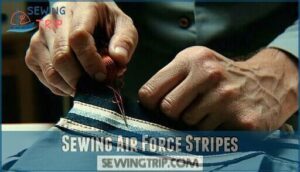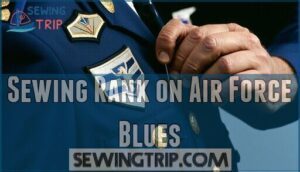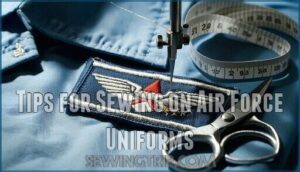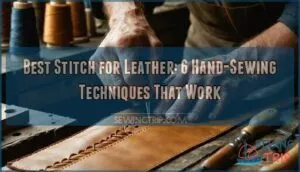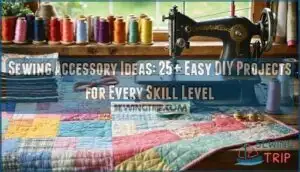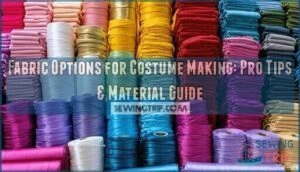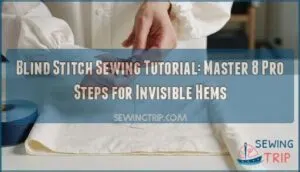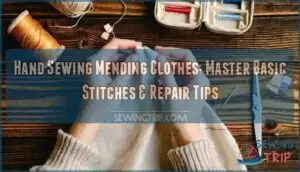This site is supported by our readers. We may earn a commission, at no cost to you, if you purchase through links.
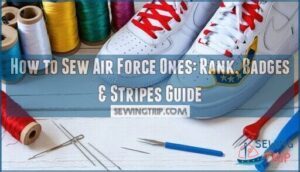 You’re looking to sew Air Force Ones, and you want to get it right.
You’re looking to sew Air Force Ones, and you want to get it right.
To start, lace your shoes as instructed, then customize with your rank, badges, and stripes by sewing them on.
You can create unique patterns with laces, like bars and stars.
When you’re ready to sew, make sure you’ve got the right thread and needles, and that’s just the beginning of perfecting your Air Force Ones.
Now that you’ve begun, you’ll want to know the specifics on sewing rank, badges, and stripes.
Table Of Contents
Key Takeaways
- You’ll need to master sneaker deconstruction, choosing quality materials and durable thread, before you can sew Air Force Ones, so don’t skip this crucial step.
- When sewing rank, badges, and stripes, you’ll want to use a chalk pencil for precise placement and sturdy thread for secure stitching, and make sure you’re following Air Force regulations.
- To achieve professional results, you’ll need to practice your stitching technique, using the right needles and thread for the job, and don’t be afraid to test your skills on scrap material first.
- Remember to choose the right needle for your fabric, check thread tension often, and use correct pressing techniques for a crisp finish, so your Air Force Ones turn out sharp and well-made.
Preparing to Sew Air Force Ones
Before you can sew Air Force Ones, you’ll need to master the art of sneaker deconstruction. Start with Material Selection by choosing quality leather, suede, or canvas for your upper and lining, plus durable thread that matches your chosen materials.
Master sneaker deconstruction with quality materials and durable thread
Next comes Stitch Removal – the make-or-break moment. Use a seam ripper or craft knife to carefully remove original stitching without damaging the underlying material. Mark your stitch lines first; this’ll save you headaches later.
Template Creation is your secret weapon. Once you’ve separated the uppers from the sole, use those original pieces as templates for reshaping and reassembling. It’s like having a blueprint for success.
Don’t skip Practice Sewing – master basic techniques like whip stitching before attempting complex details. Test your skills on scraps first; your actual sneakers will thank you. To guarantee quality stitches, it’s vital to adjust tension properly.
For Marking Placement, use chalk pencils to mark precise spots where you’ll attach custom elements. Having the right sewing tools and potentially a sewing machine will make this entire process smoother. When sewing leather sneakers, patience beats speed every time.
Sewing Air Force Rank on ABU Uniform
When attaching rank to your ABU, consider these steps:
- Choose ABU fabric
- Match thread color
- Master stitching techniques
- Place rank correctly
- Reinforce stitches
- Sew air force ones precisely
Use a chalk pencil and sturdy thread for precise placement and stitching.
For accurate placement, consider using an ABU tailoring service to ensure professional results.
Sewing Air Force Occupational Badges
After tackling rank, it’s time to give those occupational badges center stage on your uniform.
Badge Placement is key—center your patch exactly 1/2 inch above the left pocket, keeping it even and sharp. For Thread Selection, grab sturdy, 100% polyester in spice brown to match OCP fabric.
In the case of Stitch Types, a tight zigzag on your sewing machine works wonders, but if you want extra precision, hand stitch with a thimble, aiming for eight neat stitches per inch. Badge Stabilization matters too—pin or baste the badge before sewing to prevent wandering.
Collections can even be showcased using tactical display options. Remember that all badges worn must meet DAFI 36-2903 regulations.
Each patch says something about your story, so use solid Sewing Techniques and keep your stitching clean—no shortcuts on air force 1 sewing mastery.
Sewing Air Force Stripes
With badges attached, it’s time to perfect your stripe placement on Air Force uniforms.
Perfecting stripe placement is key to a sharp Air Force uniform
Position patches using double-sided tape first, then secure with matching thread and a size 3 embroidery needle.
The backstitch or whip stitch works best for stripe durability and air force 1 stitching precision.
Machine sewing presents challenges but delivers professional results when tackling multiple fabric layers.
Hand sewing offers better control for detailed air force 1 sewing work.
Choose fabric selection wisely – match your needle size to uniform material for smooth penetration.
To avoid puckering, consider using a walking foot attachment for even fabric feed.
Thread matching is vital; Spice Brown blends seamlessly with standard uniforms.
Practice your stitching technique on scrap material first, ensuring consistent tension and spacing for long-lasting stripes.
This step is crucial for achieving professional results with your Air Force uniform stripes.
Sewing Rank on Air Force Blues
Now that you’ve mastered stripes, your dress blues need the final touch of proper rank placement. Getting your rank insignia positioned correctly isn’t just about looking sharp—it’s about meeting Air Force inspection standards that can make or break your uniform evaluation.
Here’s how to nail the rank placement process:
- Position the rank insignia centered on the outer arm, halfway between shoulder seam and sleeve bottom
- Pin the insignia using straight pins to prevent shifting during stitching
- Select matching thread in spice brown or appropriate color for your uniform
- Use whipstitch technique with tight, even stitches around the patch edges
- Check alignment ensuring the silver portion sits flush with the shoulder seam
Thread selection matters more than you’d think. Quality polyester thread prevents fraying and maintains that crisp appearance through multiple washes. Your alignment guides should follow AFI 36-2903 standards—the silver part must reach the seam edge completely.
Consider using a tactical display panel to showcase badges when not in use.
Remember, sewing rank on Air Force Ones uniforms requires precision. Double-check your stitch techniques before making permanent attachments. Proper rank placement demonstrates attention to detail that inspectors notice immediately.
Tips for Sewing on Air Force Uniforms
To sew Air Force Ones, you’ll need to choose the right needle for your fabric. Consider these tips:
- Select sharp needles for woven fabrics
- Use ballpoint needles for knits
- Check thread tension often for durability.
Proper fabric selection and thread matching guarantee stitch durability, making your uniform stand out, including those Air Force Ones, by using correct pressing techniques for a crisp finish, and carefully marking placement for patches and rank on your uniform.
To prevent issues such as skipped stitches, match needles to the fabric type.
Frequently Asked Questions (FAQs)
Can I use sewing machine for leather patches?
You can use a sewing machine for leather patches, but choose the right needle and thread to avoid damaging the material, and test on a scrap piece first.
How to fix broken eyelets on Air Force Ones?
Gently tackle those pesky broken eyelets by replacing them with new ones, carefully threading the lace to secure a snug, comfortable fit on your Air Force Ones.
What is best way to clean Air Force Ones?
You’ll want to clean your Air Force Ones with mild detergent and warm water, then dry them thoroughly to prevent damage.
Conclusion
Now you’re a pro at sewing, what’s next? You’ve mastered how to sew Air Force Ones, and it’s time to show off your skills.
Remember, practice makes perfect, so don’t be afraid to try new things, you’ve got this, and you’ll be sewing like a pro in no time, with your newfound knowledge of how to sew Air Force Ones.
- https://www.usamm.com/products/abu-tailoring-service
- https://www.gocivilairpatrol.com/media/cms/UPDATED_ABU_wear_instruction_24_Oct_BEA8C45C7D2DD.pdf
- https://ogo.blob.core.windows.net/gainesvillecompositesquadron/Airman_Battle_Uniform__ABU__Wear_Guidance_2019871556284566855.pdf
- https://sd-supply.com/pages/u-s-air-force-uniform-regulations
- https://www.youtube.com/watch?v=JkJhiUtuMYM

